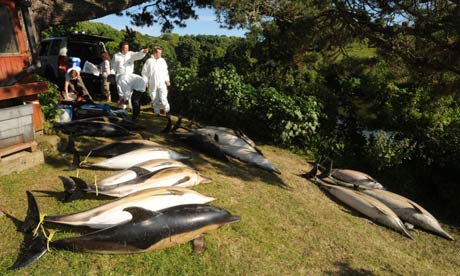Already Posted?
http://www.guardian.co.uk/environment/2008/jun/11/wildlife.conservation1The dolphins that died after beaching in Cornwall had ingested debris and mud, leading one of the scientists who examined them to compare their deaths to "mass suicide".
Vic Simpson, a pathologist who examined some of the 26 dead mammals, said today: "On the face of it, it looks like some sort of mass suicide - but the question is why? The dolphins had swallowed and inhaled big chunks of mud from the estuary. Their lungs and stomachs were full of it. That is very bizarre indeed."
Simpson, who founded the Wildlife Veterinary Investigation Centre in Truro and is examining the dolphins on behalf of the Zoological Society in London, said: "We have seen strandings on beaches, sometimes with five to seven dolphins - but never on a scale like this."
The bodies were found at four sites on the River Percuil in south Cornwall on Monday. Rescuers guided some surviving mammals back out to sea.
There are several theories, including that the dolphins may have been upset by some sort of underwater disturbance.
The Royal Navy was doing live firing exercises involving a submarine in the area at the time, and the Ministry of Defence said one of its vessels had been using short-range sonar to scan the sea bed. But a spokesman for the service said the trials were 12 miles off Falmouth. "It is considered extremely unlikely that this operation could have affected the mammals in any way. We take our environmental responsibilities very seriously and always carry out an environmental impact assessment before putting energy in the water."
Another theory is that the dolphins were frightened by a killer whale. Simpson suggested that they may have had an infection.
It is not thought they became trapped after chasing fish into shallow water because the stomachs of those that have been examined were not full of fish. Postmortem tests will not be completed for several weeks.
In Iran last year, 152 dolphins washed up on the coast, and the idea of suicide was raised, but this was dismissed as an attempt to project human motives on to a wild animal.
